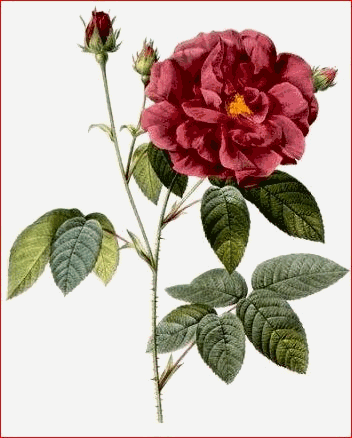
 ROSA.
U. S. (Br.) ROSE [Rosa Gallica U. S. P. IX]
ROSA.
U. S. (Br.) ROSE [Rosa Gallica U. S. P. IX]
Compiled and edited by Ivor Hughes
"Rose is the dried petals of Rosa gallica Linne (Fam. Rosaceae), collected just before the expansion of the flowers." U. S. " Red Rose petals are the fresh or dried unexpanded petals of Rosa gallica, Linn.; obtained from cultivated plants." Br.
Rosae Gallicae Petala, Br.; Red-Rose Petals; Flores Rosarum Rubrarum; Rose rouge, Rose de Provins, Fr.; Sammtrose, Zuckerrose. Franzosische Rose, Essigroseublatter, G.; Rosa rossa, It.,' Rosa roja (Flor de), Sp.
As one time pale rose or Rosa centifolia was official in addition to red rose or Rosa gallica. There is no uniformity on the subject in the several Pharmacopoeias. The Pharmacopoeia of the Netherlands and the French Codex still include both species. The German Pharmacopoeia, on the other hand, specifies only the petals of Rosa centifolia. The British and Austrian Pharmacopoeias are in unison with the U. S. Pharmacopoeia in restricting the drug to R. gallica. Rosa gallica is a shrub smaller than R. centifolia L., but resembling it in the character of its foliage. The stem is beset with short bristly prickles. The flowers are very large, with obeordate widely spreading petals, which are of a rich crimson color, and less numerous than in the R. centifolia. The stamens on thread-like filaments, and the villose styles bearing papillary stigmas, are numerous. The fruit is an oval, shining, orange red hip. The red rose is a native of the south of Europe, and is cultivated in gardens throughout the United States. The commercial supplies are obtained from France and Austria.
Description and Physical Properties.� 'Un-ground Red Rose. � Petals either separate or imbricated in small cones, broadly ovate, summit rounded and deeply notched, margin entire and somewhat recurved, base obtuse; externally of a purplish-red color except the light brown claw; texture velvety; when dry brittle; odor agreeable; taste astringent and slightly bitter. "Usually in little cone-like masses, or sometimes separate and more or less crumpled. Petals velvety, deep purplish-red passing into brownish-yellow towards the base. Fragrant odor; taste slightly astringent." Br.
The petals should be gathered before the flower has blown, separated from their claws, dried in a warm sun or by the fire, and kept in a dry place. Their odor, which is less fragrant than that of R. centifolia, is improved by drying. They have a velvety appearance, a purplish-red color, and a pleasantly astringent and bitterish taste. An illustrated article, on the structural characteristics of rose petals, whole and powdered, has been published by Hans Kramer in B. P. &., 1907, xvii, p. 354.
Various astringent principles have been suggested as occurring in rose petals. According to Peacock (Proc. Penna. Pharm. Assn., 1920, xlv, 162), they contain no gallic nor gallotannio acids, their astringency is due chiefly to a new tannin for which the name of rosatannic acid is suggested. They also contain small amounts o� quercetin.
Their coloring matter is due to the decomposition of a glucoside, anthocyanin, a sap pigment which is found in many flowers, and other plant tissues.The anthocyanins are glucosides of three parent bodies named pelargonidin, cyanidin and delphinidin. The anthocyanins are red in acid solution, violet in neutral and reddish brown to purple or blue in acid solution.
In the production of the color the glucosides are hydrolyzed by ferments of the emulsin type, the free chromogen is oxidized by atmospheric oxygen activated by oxydases. The chromogen in rose petals is cyanin which forms a chloride of the composition, C27H31O16Cl. This hydrolyzes to form cyanidin, C15H11O6 and glucose by the action of acids. Some rose petals contain as much as 10 per cent, of cyanin. Their infusion is of a pale reddish color, becoming bright red on the addition of sulphuric acid. As their color is impaired by exposure to light and air, they should be kept in opaque well-dosed bottles or canisters.
Uses. � Red rose is at present chiefly employed as an elegant vehicle.
Off. Prep. � Confectio Rosae Gallieae, Br.; Fluidextractum Rosae, U. S.; Infusum Rosas Acidum, Br. (N. F.); Confectio Rosae, N. F.; Syrupus Rosae (from Fluidextract), N. F., Br.
The US N.F. preparations may be found by using the site search box at the top right hand of the page.
![]()